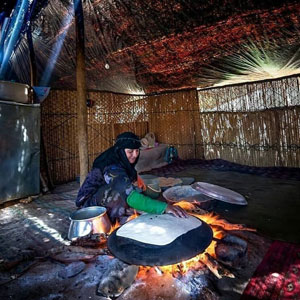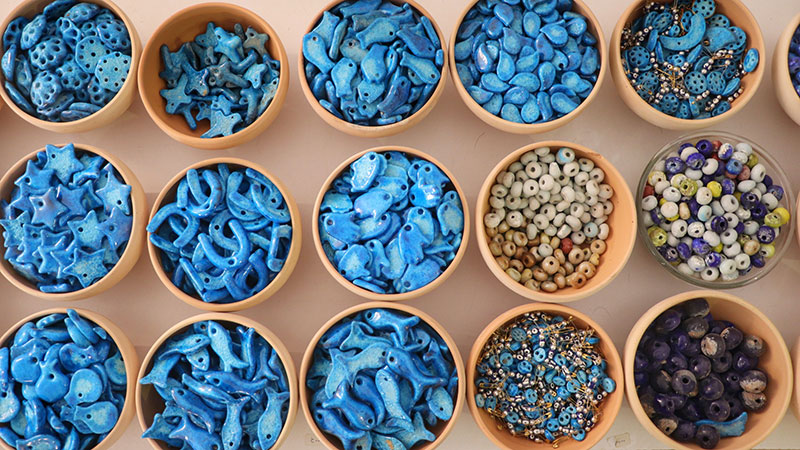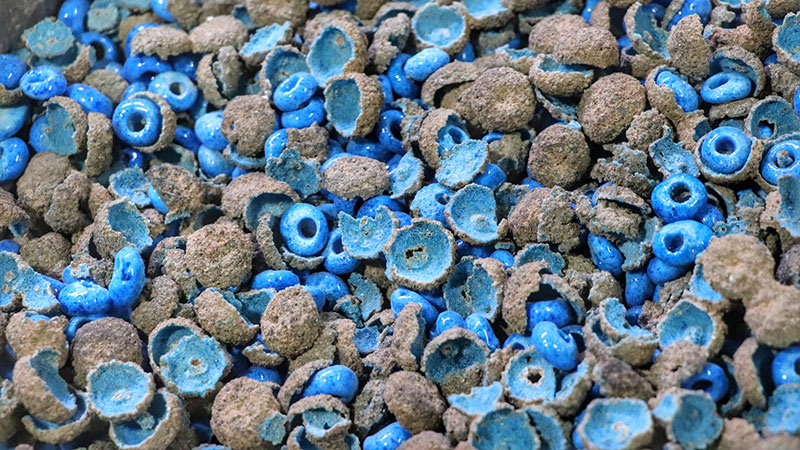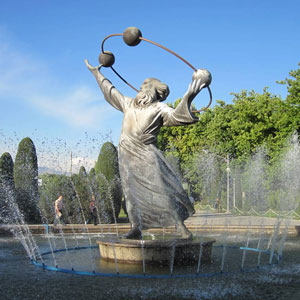 Signin with Google
Signin with Google Signin with Facebook
Signin with Facebook
 History,Activities
History,ActivitiesKharmohre, the Ancient Blue Persian Craft

From a mythical blue to a magical power
6000 years ago, in the Iranian plateau near today city of Qom, one day when the copper melting kilns were opened in a crafts workshop everybody was shocked by what has never been seen before. The body of kilns which were made from the ordinary river rocks turned into a deep, vitreous blue colour. People started to rumour the supernatural power caused the magic rocks out of the kilns and within a short time, the story of mysterious phenomenon spread all over the ancient land of Persia.
Believing the power that blue rocks were to bring, everyone wished to own even a piece of it to protect them against evil and misfortune. Craftsmen started to form the rocks and put them in the copper melting kilns to become magical and bless the kilns. The magical blue rocks were rare and rich people were using them as jewellery. Later on, the mysterious beads gained more reputation with the name of Kharmohre meaning the noble people's bead (Khar means important and big, Mohreh in Persian means bead). Khahmohre travelled to different parts of the Iranian Plateau with different names but the same meaning. In Mazandaran province, it used to be called “Kahoo Mirkaa" which has the same meaning as Kharmohre.

The blue souvenir from Qom to Egypt
Hundreds of years passed from the day in the craft workshop and finally, the secret of the oldest known type of glazed ceramic was revealed. There was a reaction between the Silica rocks with which the body of the kiln was covered, the fuel of the kiln – a native plant named Ushnan and copper oxide at high temperatures.
So the mystery of supernatural beads was discovered and Iranian craftsmen developed the technique of making it in a systematic way by grinding the silica rocks to make silica powder and mixing it with water and a natural paste to get the silica clay. Kneading the clay, they formed it using different shapes of moulds and prepared glaze powder by mixing different materials including copper oxide.
Later on, the technique was brought to Egypt and Egyptian craftsmen came up with their own version of the technique -Egyptian Paste to produce magical beads for the Pharaohs.

The rebirth of the ancient blue craft in the 20th century
By the passage of time, the production of Persian blue beads faded everywhere but in Qom, until 1937 that Hans E. Wulff recorded the technique of making Kharmohre before the floodgates of industrialization fully opened to the traditional crafts of Persia and cause them ultimate oblivion.
Hans Wulff who was trained in Germany as an engineer lived for five years in Iran to serve as the principal of the Technical College at Shiraz. Hans had to study the crafts of Iran closely upon the order of late Reza Shah Pahlavi –founder of the Pahlavi dynasty to integrate traditional technologies into the college.
Reza Shah aimed to train the men he needed for the development of the country with Western-type technologies, even though he was pleased with the results he was to safeguard the great tradition of craftsmanship of a different kind. That was then the Technical College was ordered to establish classes of traditional crafts and the beginning of Hans' interest to compile a vast glossary of technical terms of all the major crafts for the first time.
The work of recording the crafts continued after World War II and the result of this 30-year research out the craftsmen in the bazaars, farmers in the villages, and tribesmen in their nomadic tents finally came up in a book Traditional Crafts of Persia published in 1967 by MIT Press included the craftsmen's native dialect which was still alive at that time.

The name of Qom city integrated with Kharmohre
Visiting the ceramic workshop of Seyed Morteza Saadatmand in Qom who was following his ancestral crafts to make ceramic wares and Khahmohre, Hans came to know about a unique technique of Persian blue beads. Hans accompanying his daughter-in-law, who was knowledgeable in the ceramic field, realized there is only in Iran and exclusively in Qom where these mythical beads are still produced. Recording the technique of making Kharmohre, Hans Wulff was the first who referred to the production method of Kharmohre as the "Qom Technique".
After the introduction of blue beads by Hans, this heritage which has been about to be forgotten over the years was saved by the attention of the world. One more time in the late 1990s, in a research project and workshop which was conducted by the University of Kassel, the only master of “Qom technique”, Seyed Abolghasem Saadatmand – a descendant of Seyed Morteza was invited to unfold the untold secrets of the ancient technique.

Qom Technique is inscribed in the world EXPO in Hanover, Germany as an example of Human Culture and Knowledge Continuity under the number 502.
“Kharmohre, The Blue Pearl of Ancient Iran” was the project name under which kharmohre was introduced to the world one more time.
Kharmohre as the national heritage
The city of Qom is now well-known in the world where making Kharmohre has been kept alive by one tourist-friendly family named Saadatmand family. Today the knowledge of producing Kharmohre is registered as one of the intangible heritage of Iran and the city of Qom is determined to tell more and more people about the rich history behind this human heritage.
Join the experience of making Kharmohre in Qom to learn this time-honoured technique and make your fortune beads with your favourite design.



